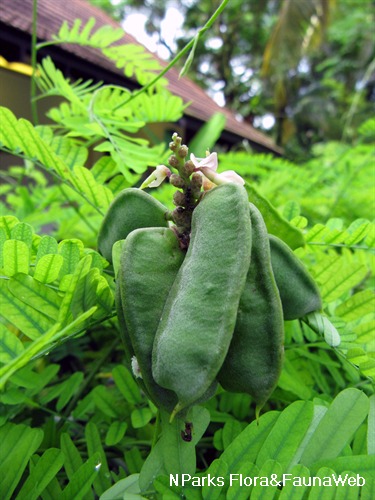
Back
Abrus precatorius L.
| Family Name: | Fabaceae (Leguminosae) |
| Synonyms: | Abrus abrus |
| Common Name: | Rosary pea, Precatory bean, Crab's eyes, 相思子 |
Name
Classifications and Characteristics
| Plant Division | Angiosperms (Flowering Seed Plants) |
|---|---|
| Plant Growth Form | Climber |
Biogeography
| Native Distribution | India |
|---|---|
| Native Habitat | Terrestrial (Secondary Rainforest) |
| Preferred Climate Zone | Tropical, Sub-Tropical / Monsoonal |
Description and Ethnobotany
| Growth Form | Abrus precatorius is a slender, perennial climber that twines around trees, shrubs and hedges. It has no special organs of attachment. |
|---|---|
| Fruit | The fruit (pod) is flat, oblong and truncate-shaped with sharp deflexed beak about 3-5cm long, 1.2 cm wide, and silky-textured. The seedpod curls back when it open to reveal the seeds. |
| Habitat | Naturally grow in fairly dry regions at low elevations. |
| Ethnobotanical Uses | Medicinal: The plant is used in some traditional medicine to treat scratches and sores, and wounds. The leaves are used for their anti-suppurative. In China, the seed were once used to treat fever, malaria, headache, worms and dropsy. In Indochina, the roots are used to treat diarrhoea and the bark for dysentery, while in Burma the root is used to treat cough. Various African tribes used powdered seed as oral contraceptives. Boiled seeds are eaten in certain parts of India.
Caution: (The seeds containing abrin which are highly poisonous when if the seed coat is cracked. A single seed can cause blindness or even death if ingested. Others: The seeds are used to made necklaces and other ornaments. In some countries, they used it in their handiwork and to count in school. |
Plant Care and Propagation
| Light Preference | Full Sun, Semi-Shade |
|---|---|
| Water Preference | Moderate Water |
| Plant Growth Rate | Fast |
| Propagation Method | Seed |
Foliar
| Mature Foliage Colour(s) | Green |
|---|---|
| Mature Foliage Texture(s) | Smooth |
| Foliar Type | Compound (Even-Pinnate) |
| Foliar Arrangement Along Stem | Alternate |
| Foliar Shape(s) | Non-Palm Foliage |
Non - Foliar and Storage
| Bark Colour(s) | Brown |
|---|---|
| Mature Bark Texture | Smooth |
Floral (Angiosperm)
| Flower Colour(s) | Pink, Purple |
|---|---|
| Flower Grouping | Cluster / Inflorescence |
| Flower Location | Axillary |
Fruit, Seed and Spore
| Mature Fruit Colour(s) | Brown |
|---|---|
| Mature Fruit Texture(s) | Smooth |
| Fruit Type | Dehiscent Dry Fruit |
| Mature Seed Texture(s) | Smooth, Glossy / Shiny |
| Seed Description | Oval-shaped, about 0.6 cm. Mature seed has hard and impermeable seed coat. |
| Seed Quantity Per Fruit | Few (1-5) |
Image Repository
Others
| Master ID | 29171 |
|---|---|
| Species ID | 3480 |
| Flora Disclaimer | The information in this website has been compiled from reliable sources, such as reference works on medicinal plants. It is not a substitute for medical advice or treatment and NParks does not purport to provide any medical advice. Readers should always consult his/her physician before using or consuming a plant for medicinal purposes. |




